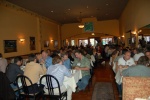Monday Dinner (click to enlarge) |
Last night's conference dinner was very well attended and very good.
We started the morning in true unconference fashion by putting together the agenda. This happens by having anyone who wants to lead a session write it down on an 8.5x11 inch piece of paper and post it on a time grid on the wall. Everyone who posts something gets an opportunity to say something about their session. the agenda is fairly full and there are some good topics.
Putting together the agenda (click to enlarge) |
Kaliya said that the guy who invented open space spent a year planning a conference and then had someone tell him that the breaks were the best part of the conference. So, he decided to create a conference that was less structured. You might say that the theme of open space is "all breaks, all the time." After everyone had introduced and posted their session, there was 30 minutes or so before they were set to begin. There was some jockeying to get things in the right place and not opposite potentially conflicting topics. All in all, pretty good.
The first session I went to was Gail-Joon Ahn from Univ. of North Carolina. Gail-Joon and his students built an open source implementation of InfoCards. They're interested in creating potable, interoperable, and multi-modal identity card selectors (part of InfoCard).
Gail-Joon Ahn and students (click to enlarge) |
Gail-Joon's students demo'd a Java version of the InfoCard selector. The demo included logging into a site using a selected InfoCard, creating cards, and interacting with identity providers and relying parties in a couple of scenarios. All of the code is in Java. This is an impressive effort, but also illustrative of the fact that InfoCard
- doesn't have to be just a .Net/Microsoft thing and
- is simple enough to allow multiple implementations.
Part of their work involves moving InfoCard beyond the desktop and to mobile devices. They demo'd what's called an "i-button" that contains a secure token. The i-button could be on a ring or key fob. There was also a demo showing an InfoCard selector on a mobile phone.
Chuck Mortimore did a 5-minute demo of a Firefox plugin he's done for InfoCards. He created a card and then logged into Kim Cameron's blog using the card. Pretty cool.
Kim Cameron took over to show the code that Chuck was hitting on his blog. The relying party stuff he's using is all written in PHP. Kim showed various debugging tools for seeing what's going back and forth and demo'd the use of various InfoCard pieces from various players together.
In the second session of the morning, I dropped into a discussion led by Yan Cheng (AOL) on making identity systems work together. He came up with a three-axis diagram that he used to classify identity systems. Each axis represented a context that the identity system supported. One axis was "business," another was "private," and the third was "public."
To give some examples, Yan saw things like InfoCard, AOL, and other similar systems as more in the private context. LID, OpenID, SXIP with along the public access. Liberty was associated with the business axis. As you can imagine, this engendered considerable discussion--that's good.







